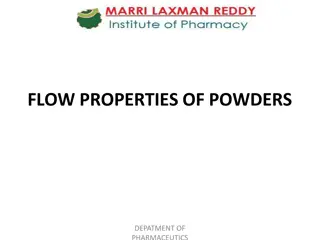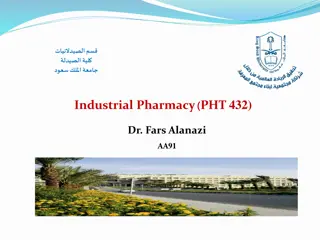Understanding Powder Flow Properties in Pharmaceutics
Powder flow properties play a crucial role in pharmaceutical manufacturing processes. Free-flowing or cohesive powders can lead to various challenges like uneven flow, caking during storage, and issues in dosing uniformity. Testing methods such as Carr's compressibility index and Hausner ratio help
0 views • 19 slides
Importance of Size Reduction in Pharmacy: Advantages and Disadvantages
Size reduction plays a crucial role in pharmacy by enhancing solubility, extraction rate, mixing quality, and more. However, there are also potential drawbacks such as changes in drug stability and flowability issues that need to be considered. Understanding the benefits and limitations of size redu
1 views • 58 slides
Wet Granulation Method in Industrial Pharmacy: Steps and Advantages
Wet granulation method in industrial pharmacy involves weighing and mixing ingredients, preparing a damp mass, converting it into wet granules, drying, dry screening, and mixing with lubricants. This method improves flowability, cohesiveness, and compressibility of powders, making them easily compre
0 views • 9 slides
Overview of Tablet Compression Processes and Granulation Methods
Powders for tablet compression must have good flowability and compressibility properties. Techniques like slugging and dry compaction are used in the production of tablets by compacting powders into granules. Dry granulation may lead to fines or non-compacted products, requiring cohesive properties.
0 views • 11 slides
Understanding Tablet Production Methods and Properties
Tablet production techniques such as direct compression and granulation are essential steps involving powder milling, mixing, and tabletting. The use of crystalline structures and disintegrants impact the compressibility and flowability of tablets. Not all materials are suitable for direct compressi
0 views • 18 slides




